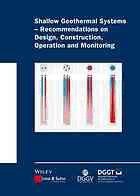
Shallow geothermal systems - recommendations on design, construction, operation and monitoring: of the Geothermal Energy Study Group at the specialist Hydrogeology Section of the German Geological Society (FH-DGGV) and the Engineering Geology Section of t PDF
Preview Shallow geothermal systems - recommendations on design, construction, operation and monitoring: of the Geothermal Energy Study Group at the specialist Hydrogeology Section of the German Geological Society (FH-DGGV) and the Engineering Geology Section of t
Shallow Geothermal Systems – Recommendations on Design, Construction, Operation and Monitoring – Shallow Geothermal Systems Recommendations on Design, Construction, Operation and Monitoring Of the Geothermal Energy Study Group at the specialist Hydrogeology Section of the German Geological Society (FH-DGGV) and the Engineering Geology Section of the German Geotechnical Society and the German Geological Society (FI-DGGT/DGGV). Edited by German Geological Society e.V. (DGGV) and the German Geotechnical Society e.V. (DGGT) DeutscheGesellschaftfürGeotechnike.V. DeutscheGeologischeGesellschaft– vertr.durchdenVorsitzenden GeologischeVereinigunge.V. HerrnDr.-Ing.WolfgangSondermann vertr.durchdenVorsitzenden Gutenbergstr.43 HerrnProfessorDr.JanBehrmann 45128Essen BuchholzerStr.98 Germany 30655Hannover Germany Authors:Sass,I.,Brehm,D.,Coldewey,W.G.,Dietrich,J.,Klein,R.,Kellner,T.,Kirschbaum,B., Lehr,C.,Marek,A.,Mielke,P.,Müller,L.,Panteleit,B.,Pohl,S.,Porada,J.,Schiessl,S., Wedewardt,M.,Wesche,D. TranslatedbyPhilippThrift,Hannover Cover:Schematicdrawingsshowingthearrangementsofthedifferentsystems,Graphic:Sass& Mielke2012 LibraryofCongressCardNo.:appliedfor BritishLibraryCataloguing-in-PublicationData AcataloguerecordforthisbookisavailablefromtheBritishLibrary. BibliographicinformationpublishedbytheDeutscheNationalbibliothek TheDeutscheNationalbibliothekliststhispublicationintheDeutscheNationalbibliografie;detailed bibliographicdataareavailableontheInternetat<http://dnb.d-nb.de>. 2016WilhelmErnst&Sohn,VerlagfürArchitekturundtechnischeWissenschaftenGmbH& Co.KG,Rotherstraße21,10245Berlin,Germany Allrightsreserved(includingthoseoftranslationintootherlanguages).Nopartofthisbookmay bereproducedinanyform–byphotoprinting,microfilm,oranyothermeans–nortransmittedor translatedintoamachinelanguagewithoutwrittenpermissionfromthepublishers.Registered names,trademarks,etc.usedinthisbook,evenwhennotspecificallymarkedassuch,arenottobe consideredunprotectedbylaw. Coverdesign:DesignPur,Berlin Typesetting:ThomsonDigital,Noida,India PrintingandBinding: PrintedintheFederalRepublicofGermany. Printedonacid-freepaper. PrintISBN:978-3-433-03140-7 ePDFISBN:978-3-433-60670-4 ePubISBN:978-3-433-60668-1 eMobiISBN:978-3-433-60669-8 oBookISBN:978-3-433-60667-4 Contents Preface....................................................................................... IX Acknowledgements.................................................................. XIII ListofFigures........................................................................... XV ListofTables............................................................................. XXV Preamble.................................................................................... XXVII Notation.................................................................................... XXIX 1 Introduction..................................................................... 1 2 Principles......................................................................... 5 2.1 Geological,hydrogeologicalandgeotechnicalprinciples.... 5 2.2 Geothermalprinciples........................................................... 12 2.3 Solarenergyzone................................................................. 29 2.4 Geosolartransitionzone....................................................... 31 2.5 Terrestrialzone..................................................................... 35 2.6 Anthropogenicthermalinfluence......................................... 36 2.7 Interactionbetweengeothermalenergysystemsandthe ground................................................................................... 37 2.7.1 Hydrochemicalinteractions.................................................. 39 2.7.2 Interactionsbetweengeothermalsystemsandgroundwater organisms.............................................................................. 39 3 Geothermalenergyinstallations................................... 41 3.1 Closedsystems..................................................................... 42 3.1.1 Boreholeheatexchangers(downholeheatexchangers)....... 42 3.1.2 Heatpipes............................................................................. 50 3.1.3 Horizontalcollectors............................................................. 51 3.1.4 Thermalpilesandconcretecomponentsincontact withthesoil.......................................................................... 55 3.2 Opensystems(directuseofgroundwater)........................... 59 3.2.1 Wellsystems......................................................................... 61 3.2.2 Geothermalenergyinconjunctionwithminesand undergroundworkings.......................................................... 65 3.3 Geothermalenergystorageconcepts.................................... 70 V 3.3.1 Aquiferthermalenergystorage............................................ 70 3.3.2 Boreholethermalenergystorage.......................................... 71 3.3.3 Cavernthermalenergystorage(CTES)................................ 72 4 Legislativeprinciples..................................................... 73 4.1 Waterlegislation................................................................... 73 4.1.1 Europeanregulations............................................................ 73 4.1.2 Nationallaw.......................................................................... 74 4.2 Mininglegislation................................................................. 74 4.3 Naturalmineraldepositslegislation..................................... 75 4.4 Natureandlandscapeconservation...................................... 75 4.4.1 Theeuropean‘natura2000’ecologicalnetwork.................. 75 4.4.2 Natureandlandscapeconservation...................................... 76 4.5 Environmentalimpactassessment........................................ 77 4.6 Non-statutoryregulations..................................................... 77 5 Planningprinciples......................................................... 78 5.1 Projectworkflow................................................................... 79 5.1.1 Establishingthebasisoftheproject..................................... 79 5.1.2 Preliminarydesign................................................................ 80 5.1.3 Finaldesign.......................................................................... 80 5.1.4 Buildingpermissionapplication........................................... 81 5.1.5 Detaileddesign..................................................................... 81 5.1.6 Preparingforcontractawardandassistinginawardprocess.... 82 5.1.7 Supervisingandsettinguptheoperation............................. 82 5.2 SurveyingrequirementsforBHEinstallations..................... 83 5.2.1 Geothermalcategory1.......................................................... 83 5.2.2 Exploratorymeasuresforcategory1.................................... 84 5.2.3 Geothermalcategory2.......................................................... 84 5.2.4 Additionalexploratorymeasuresforcategory2.................. 84 5.2.5 Geothermalcategory3.......................................................... 84 5.2.6 Additionalexploratorymeasuresforcategory3.................. 84 5.3 Modelsforsimulatingheattransfer...................................... 85 6 Boreholesandcompletion............................................. 91 6.1 Drillingmethods................................................................... 91 6.2 Equipmentinboreholes........................................................ 94 6.3 Boreholes:deviationfromthevertical................................. 97 6.4 Geologicalandhydrogeologicalinfluences.......................... 104 VI 6.5 Responsetestmethods.......................................................... 109 6.5.1 GRTconceptsandmeasuringprinciple............................... 110 6.5.2 Evaluation............................................................................. 111 6.5.3 Thermalresistanceofborehole............................................. 115 6.5.4 QualitycontrolwiththehelpoftheGRT............................ 117 6.5.5 EvaluationofunsteadyGRTdata........................................ 118 6.5.6 Cylindersourcemethod........................................................ 119 6.5.7 Enhancedgeothermalresponsetest...................................... 136 7 Design,constructionandoperationof closedsystems............................................................... 143 7.1 sBHEsystems........................................................................ 143 7.1.1 Detaileddesign..................................................................... 143 7.1.2 Backfillingtheannularspace................................................ 155 7.1.3 Requirementsprofileforbackfillmaterial............................ 158 7.1.4 BHEsthatarenotfullysealed.............................................. 177 7.1.5 PressureandflowtestsforBHEs......................................... 179 7.1.6 Thermaltransferfluids.......................................................... 190 7.1.7 Horizontalconnectingpipesandconnectionto buildingservices................................................................... 194 7.1.8 Commissioning,operationandmaintenance........................ 196 7.1.9 Documentation...................................................................... 199 7.1.10 Abandoninganddecommissioning...................................... 200 7.2 Horizontalcollectors............................................................. 201 7.2.1 Planninganddesigningcollectorsystems............................ 201 7.2.2 Installationofhorizontalcollectors...................................... 205 7.2.3 Installationofgeothermalenergybaskets............................ 205 7.2.4 Layingthepipes................................................................... 206 7.2.5 Fillingandbleeding.............................................................. 206 7.2.6 Thermaltransferfluids.......................................................... 207 7.2.7 Pressuretests......................................................................... 207 7.2.8 Commissioning..................................................................... 207 7.2.9 Documentation...................................................................... 207 7.2.10 Operationofhorizontalcollector.......................................... 209 7.2.11 Effectsofoperatinghorizontalcollectors............................. 209 7.2.12 Abandoninganddecommissioning...................................... 210 8 Design,constructionandoperationofopensystems 211 8.1 Wellsystems......................................................................... 211 8.1.1 Detaileddesign..................................................................... 218 VII 8.1.2 Sitesupervision,qualityassurance,documentation............. 220 8.1.3 Pumpingandwelltests......................................................... 220 8.1.4 Commissioning,operationandmaintenance........................ 220 8.1.5 Hydrochemicalandmicrobiologicalinfluences................... 225 8.1.6 Documentation...................................................................... 230 8.1.7 Abandoninganddecommissioning...................................... 230 8.1.8 Practicalexampleofawellsystem...................................... 230 8.2 Aquiferthermalenergystorage(ATES)............................... 235 9 Riskpotential................................................................... 236 9.1 The5-Mmethod................................................................... 236 9.1.1 Man....................................................................................... 236 9.1.2 Method.................................................................................. 237 9.1.3 Materials............................................................................... 238 9.1.4 Machines............................................................................... 239 9.1.5 Medium................................................................................. 239 9.1.6 Summary............................................................................... 240 9.2 Geologicalrisks.................................................................... 241 9.2.1 Rockswithswellingorsubsidencepotential........................ 241 9.2.2 Solublerocks........................................................................ 241 9.2.3 Overconsolidatedrocksandrockssusceptibletoporewater pressure................................................................................. 242 9.2.4 Tectonics............................................................................... 242 9.2.5 Massmovements.................................................................. 243 9.2.6 Collapses,subsidenceandminingsubsidence..................... 243 9.2.7 Gasescape............................................................................ 243 9.3 Hydrogeologicalrisks........................................................... 244 9.3.1 Confinedandartesiangroundwater...................................... 244 9.3.2 Multi-layergroundwatersystems......................................... 245 9.3.3 Hydrochemicalgradients...................................................... 245 9.3.4 Venting................................................................................. 246 9.3.5 Waterquality........................................................................ 246 9.4 Environmentalrisks.............................................................. 247 9.4.1 Legacypollutionanddeposits.............................................. 247 9.4.2 Mining,miningdamage........................................................ 248 9.5 RisksduringBHEinstallation.............................................. 248 9.6 Operationalrisks................................................................... 249 Literature.................................................................................... 253 Glossary..................................................................................... 264 VIII Preface Theuseofshallowgeothermalenergyhasincreasedenormouslyoverthepast tenyears.Asthenumberofgeothermalenergyinstallationshasrisen,sohas the numberof technical developments in the field. There have been casesof damage in connection with the construction and operation of geothermal energysystemswhichhaveattractedmuchattentioninthemedia.Inparticular, the cases of damagethat have become publicshow that drilling to depths of several hundred metres is a technical activity that calls for responsible proceduresinthesenseofquality-assureddesign,constructionandoperation of the systems. Avoiding damage caused by shallow geothermal energy installationsisatoppriorityforsustainablegeothermalenergyuses,especially whenbodiesofgroundwaterhavetobeprotectedagainstadverseeffects.The recommendations in this book should be regarded as contributions to the quality-assuredrealisationofsuchsystems.OneoftheaimsoftheGeothermal Energy Study Group at the specialist Hydrogeology Section of the German GeologicalSociety(DGGV)andtheEngineeringGeologySectionofboththe German Geotechnical Society (DGGT) and the DGGV is to promote the widespread use of geothermal energy as an environment-friendly energy source while prioritising the protection of bodies of water. The authors as wellastheDGGVandtheDGGThaveconceivedtheserecommendationsas advice and not as a set of technical regulations in the sense of a standard. Therefore, the recommendations of the Geothermal Energy Study Group include a number of textbook-like passages and much information on the legislationthataffectsapprovalsandpermits.Atthetimeofgoingtoprint,the preparationofastandardforshallowgeothermalenergywasnotinsight;such a standard is, however, still regarded as essential. The authors and their assistants in the study group are hydrogeologists, engineering geologists and engineers from design consultants, the construc tion industry, the building materials industry, authorities and universities. Theydrewuptherecommendationsoveranumberofyearsandallwerewell awareofthefactthatsomeofthecontentcouldcertainlytriggercontroversy in technical circles. In order to guarantee the technical quality of the recommendations of the GeothermalEnergyStudyGroup,thecontentwassubjectedtoapeerreview process.Prof.Dr.IngridStober(FreiburgRegionalAuthority),Prof.Dr.Rolf Bracke(InternationalGeothermalCenter,Bochum)andProf.Dr.DmitryV. Rudakov (National Mining University, Dnipropetrovsk) undertook this important and demanding task, approaching it from different perspectives. IX Theirremarksandcommentswerecarefullyconsideredinthepreparationof this current edition of the recommendations. Besides the peer review process, the publishers made the recommendations publicly available on the Internet for three months. Anybody who was interested was invited to submit their remarks, comments and suggestions forimprovementswithinthosethreemonths.Theauthorsreadandevaluated every single contribution received, which resulted in many improvements beingmadetothetextandillustrations.Weareverygratefultoallwhomade contributions to the work of the study group in this way. The authors of the recommendations are as follows: Spokesman for the study group Prof. Dr. rer. nat. Ingo Sass Institute of Applied Geothermal Science & Technology Technische Universität Darmstadt Schnittspahnstr. 9 64287 Darmstadt Deputy spokesman Dr. rer. nat. Dirk Brehm BGU, Bielefeld Permanent members of the study group Prof. Dr. rer. nat. Wilhelm Georg Coldewey Institute of Geology & Palaeontology Westfälische Wilhelms-Universität Münster Dr. rer. nat. Jörg Dietrich HeidelbergCement, Enningerloh Dr. rer. nat. Rainer Klein boden & grundwasser, Amtzell Dipl.-Min. Torsten Kellner Berlin Dipl.-Ing. Dipl.-Geol. Bernd Kirschbaum Federal Environment Agency, Dessau X
